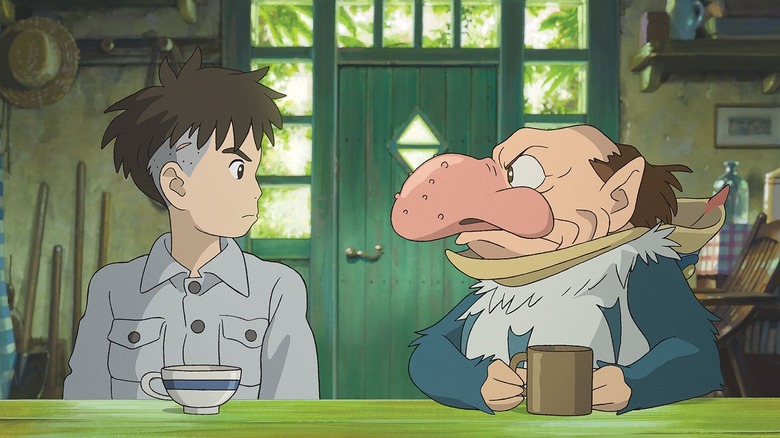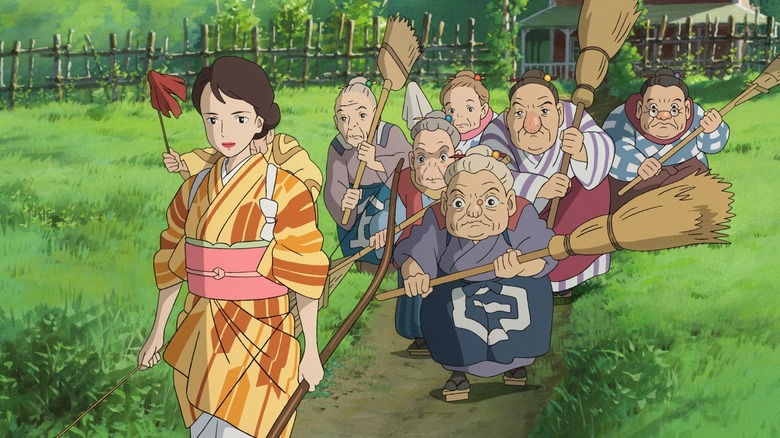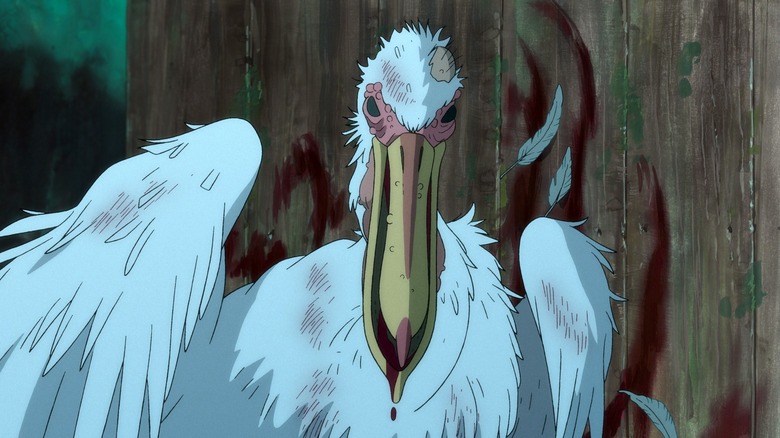The Boy And The Heron Review: Every Miyazaki Movie All At Once
- Absolutely gorgeous
- Original while also recalling Ghibli classics
- A wealth of metaphors worth pondering
- Confusing to understand on first viewing
Heading into the international premiere of "The Boy and the Heron" at the 2023 Toronto International Film Festival, there were two big sources of hype: this is the first Hayao Miyazaki movie since "The Wind Rises" 10 years ago, and it was widely expected that it would be his last. The latter claim may very well prove incorrect — CBC reporter Eli Glasner has posted on Twitter that Studio Ghibli's Vice President Junichi Nishioka is already claiming Miyazaki is at work on planning new films. Miyazaki is infamous for "retiring" before making yet another masterpiece, and the 82-year-old animation director will likely be directing for the rest of his life.
Despite this latest un-retirement, it's easy to see "The Boy and the Heron" as Miyazaki's attempt at a final statement on his career. His previous "final" statement, "The Wind Rises," was an uncharacteristically low-key and grim one, an "Oppenheimer"-esque reflection of looking back on a life's accomplishments and finding horror. "The Boy and the Heron" shares a World War II setting with "The Wind Rises," but brings back the vibrant fantasy elements that have defined the director's most beloved work and sets out to deliver a more optimistic message for future generations.
For those who've seen and loved any Miyazaki film in the past — and let's be honest, that phrase is redundant when basically everyone who's seen Miyazaki's movies loves them — "The Boy and the Heron" doesn't need reviews to tell you to go. In Japan, it didn't even need trailers, releasing only a single poster for its whole ad campaign (American distributor GKIDS has released a striking and intentionally vague trailer). While this review doesn't contain major spoilers, those wishing to go into "The Boy and the Heron" with a complete blank slate are advised to not read further ahead. All you need to know is that it's great, if not as instantly lovable as a "Spirited Away" or a "Kiki's Delivery Service," and that you'll probably want to read reviews after seeing it to process what the hell you just watched.
A culmination of everything Studio Ghibli has made
The opening scene of "The Boy and the Heron" looks like nothing Hayao Miyazaki has made before. In subject matter, the closest comparison in the Studio Ghibli library is to Isao Takahata's "Grave of the Fireflies." In style, it's less realistic and more fluidly chaotic in a way that takes the expressionism of "The Tale of the Princess Kaguya" to elaborate extremes. This opening is Miyazaki's "Guernica," the rawest, most overwhelming expression of the horrors of war — and the tragedy of losing a mother.
Lest the movie become too horrific, it doesn't stay put in this setting for long. Following the death of his mother Hisako, the young protagonist Mahito Maki (voiced by Soma Santoki in Japanese) and his father Shoichi (Takuya Kimura) flee the firebombing of Tokyo to an estate in the countryside. This act of the film is like a sadder, angstier version of "My Neighbor Totoro," as Mahito explores and adjusts to a new setting while gradually uncovering magical elements in nature. This eventually transitions into something closer to the "Alice in Wonderland"-style adventure of "Spirited Away," with the even more freewheeling magic of "Howl's Moving Castle" and the cycle-of-nature existentialism of "Princess Mononoke."
As with all of Miyazaki's best movies, "The Boy and the Heron" is filled with the weirdest characters you'll still want to buy lots of toys of. Love Miyazaki's old ladies? Here you get seven of them, swarming over each other around the estate like Miyazaki's version of the Seven Dwarfs (not the only Snow White-inspired imagery to show up in the film). Love his tiny cute things? Wait until you get a load of the warawara, which somehow surpass the kodama from "Princess Mononoke" in this department. And if your favorite characters are the absolute freaks, then you are going to love The Grey Heron (Masaki Suda), an ambiguous shapeshifting creature — is he actually a heron or a big-nosed guy in a heron costume? — who can be majestic, funny, or terrifying depending on the mood. I wouldn't dare even give a hint of a spoiler as to just how great and bizarre the parakeets are.
Is this a movie for children? I'm not sure
In Japan, "The Boy and the Heron" is titled "How Do You Live?" This title comes from a 1937 children's book of philosophical parables by Genzaburo Yoshino. Hayao Miyazaki's film is not an adaptation of the book, though the book itself does appear in an emotional scene that seems at least semi-autobiographical. Thematically, there are connections; stylistically, they couldn't be more different.
Whereas Yoshino's novel directly explains big ideas to children in ways they could easily understand and relate to, I'm not sure what kids will make of "The Boy and the Heron." Beyond basic concerns about violence and frightening imagery that will almost certainly earn the film a PG-13 rating, Miyazaki barely attempts to explain anything outside of a few key moments. There are just so many weird twists, unstable realities, and complicated metaphors that it's hard enough to fully comprehend on first viewing as an adult, let alone a child. Of course, sometimes children can understand things better than adults can.
So what do I think it's about after just one screening? Well, it's at least partially about the love between parents and children, and how such connections can transcend space and time. That theme gets layered by the very public knowledge that Miyazaki was a terrible father to his son Goro, and the story's climax could be seen as being about questions on what is right for the elderly to demand of the next generation. It's a celebration of Studio Ghibli's creativity that also sees nothing to fear in the idea that it all might die very soon. And it's about birds. Even if it's not Miyazaki's swan song, this movie sure knows that birds are cool.
"The Boy and the Heron" opens in American theaters on December 8, following preview showings on November 22.


